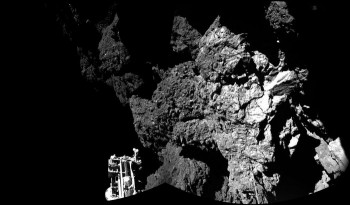Data from both the Philae lander and Rosetta orbiter experiments, as well as simulation results based on Philae’s mechanical design have been used to reconstruct the lander’s attitude and motion during its descent and touchdowns on Comet 67P/Churyumov-Gerasimenko on 12 November 2014. A new animation was presented today, one year after Philae touched down on the comet, focusing on Philae’s dramatic two-hour flight from Agilkia to Abydos – in this blog post we hear from some of the people behind its production.
Over the last year, more and more details about exactly what happened have been gleaned from a detailed evaluation of data from various instruments and sensors. These have provided an extensive account of the events from the moment Philae separated from Rosetta, through its seven-hour descent, and the subsequent two-hour flight across the surface that included three touchdowns and a collision.
A numerical simulation of Philae, calibrated and verified with test data from a mock-up of the lander, was used to model its interaction with the surface at Agilkia. The subsequent free flight and later bounce dynamics were reconstructed from the trajectory in conjunction with attitude information derived from the ROMAP instrument.
Together, these efforts made it possible to determine Philae’s behaviour on 12 November 2014 with sufficient accuracy to make this new visualisation.
Philae’s first touchdown on the comet (TD1) at 15:35 UT is constrained by a very precise knowledge of its landing position and orientation based on ROLIS images, the times at which the three feet contacted the surface as measured by SESAME, the vertical dynamics from the damping tube housekeeping data, lander dynamics simulations explaining the footprints imaged later by OSIRIS, outbound attitude reconstructed from ROMAP and RPC-MAG data, and the outbound velocity vector based on a trajectory reconstruction.
Felix Finke of DLR, one of the scientists responsible for the production of the animation said, “By animating Philae’s spaceflight, we are gaining an incredibly unique insight into what really happened during Philae’s touchdowns last year.”
“This animation and the data it relies upon is providing the basis of the still on-going discussion about Philae’s fate on the comet,” added Philip Heinisch from TU Braunschweig.
Immediately after the first touchdown, Philae’s on-board stabilising flywheel was turned off and its residual angular momentum transferred to the lander itself. This caused the lander to spin up, reaching a rotation period of about 13 seconds. This simple rotation decayed into a tumbling nutation after the collision of one leg with the rim of the Hatmehit crater at 16:20 UTC.
The animation provides an impressive illustration of the subsequent chaotic flight behaviour up to the second touchdown (TD2) at 17:25 UT. The tumbling motions of the lander during this phase have been reconstructed using magnetic field measurements made by the ROMAP experiment. Even in the low ambient magnetic field of the cometary environment, both rotation and nutation could clearly be identified.
Hans-Ulrich Auster, PI of the ROMAP magnetometer at TU Braunschweig explained: “The subsequent contact of the tumbling Philae with the surface at the second touchdown was the most critical one. The lander made contact with the surface and Philae left the comet again, controlled by the two legs to the left and to the right of the balcony and performed a final rotation, a backward roll, about the lander Y-axis.”

Welcome to a comet! Philae’s first images from Abydos. ESA/Rosetta/Philae/CIVA
Fortunately, the momentum was still large enough to right the lander up onto its legs again and eventually into its final resting position at Abydos at 17:31 UT. The magnetometer team also reconstructed the backward loop between the second and third touchdowns, along with the final attitude at its resting place, in front of the landscape seen in the CIVA images.
“With hindsight, one year later, and watching the movie, I am astonished how lucky we were!” says Jens Biele, the lead author of the first scientific paper relating lander impacts to surface properties. “But we learned a lot about the surface mechanical properties from these bounces, and Philae finally landed in an interesting terrain where we would have never dared to land in the first place!”
Detailed scientific and engineering analyses of the underlying data will be published in an upcoming special issue of Acta Astronautica.
More about Philae’s descent and trajectory:
Reconstructing Philae’s trajectory
Did Philae graze a crater rim during its first bounce?
OSIRIS view of Philae drifting across the comet
Also see: Biele et al., The landing(s) of Philae and inferences about comet surface mechanical properties









Discussion: 7 comments
what an incredible and beautifull reconstruction it is to see it over and over again.. Mr jens Biele is deadright with his last comment. Philae gave us an unexpected and exiting tour across the comets surface.
is it possible to render that with more than 1 Frame per second ? looks like an old C64 Animation.
nice fog effects 🙂
Remarkable! There seems to be a great deal of luck involved. What have we learned from Philae that will make the next landing on a low-g object a first timer?
Next time a hopper, maybe?
This is a repost. But think more sampling data could be obtained with a cooper rail gun. Maybe shutting against a sun rising horizon.
And now see and make it work one more time
Amazing how the fly wheel contributed to Philae survival, Emily 🙂